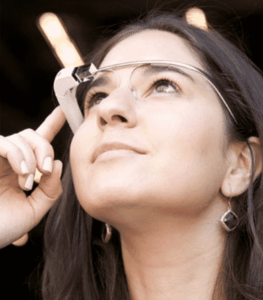Wearable Technology and What It Means for the Workplace

Technology that you can carry with you, such as laptops and mobile devices, is no longer considered cutting edge. Now, the latest trend is technology you can wear. According to KPCB’s 2013 Internet Trends, wearable technology, such as glasses, watches, and wristbands, are showing early signs of growth and traction, and will potentially affect the way we do business.
Google, Apple, Microsoft, and Samsung are all reportedly developing wearable devices, with Google Glass receiving the most press attention. While most of these devices are still in the development phase and their current incarnations have limited utility, software updates and applications are increasing their usability on a daily basis. According to a recent in-depth study, while only 18% of American respondents use wearable technology, 82% of those users believe these devices have enhanced their lives.

Forbes believes that wearable devices will truly hit the market in 2014, and Business News Daily urges business owners to prepare for wearable devices as an inevitable part of business. So what does wearable technology mean for the future of the workplace?
First, I believe that wearable technologies will offer many benefits for the productivity of employees and the efficiency of information exchange. Mobile technologies are already widely used by at-home and remote workers, as well as office workers conducting business after hours. But while mobile technology offers portability, timely information, and anywhere access, there are many inefficiencies and limitations associated with the devices.
The aforementioned KPCB study reports that mobile device users check their smartphones 150 times per day. Intuit explains how limited applications and clumsy data entry sometimes makes mobile devices less time-efficient than stationed technologies. However, wearable technologies offer possible solutions for both of these problems.
In contrast to mobile devices, many wearable devices offer a seamless viewing experience. According to one of the first non-Google users of Google Glass, the device’s interface is viewable through a tiny TV overlay on your eye, allowing you to check notifications without interrupting your engagement with your immediate surroundings. Google Glass also lets you use voice commands to dictate text or search the Internet. In a business context, this allows for hand-free email dictation and Internet research.
Other employee productivity benefits include instant note-taking, hands-free video conferencing, and increased fluidity of experience between employees.
Wearable devices also have the ability to interface with your existing mobile technologies. For example, the Pebble watch uses Bluetooth to connect to your iPhone or Adroid device. And the device receives software updates wirelessly. In these ways, wearable devices will be able to extend the portability of our devices and make out-of-office tasks more seamless and efficient.
However, there are also many potential drawbacks to wearable devices. As with many technological developments, most of these drawbacks center on issues of security.
While many companies already have security measures in place for things like social networking and mobile devices, wearable technology poses a new and heightened threat to business security.
Discreet devices like watches and glasses can allow employees to easily take pictures or videos of private information, unreleased prototypes, or trade secrets. Devices with storage capabilities could even allow for the covert transfer of secure files.
In the aforementioned Business News Daily article, Steve Bjarnason, a certified information systems security professional (CISSP), urges business owners to take steps now for preventing data leakage in the future.
“In the case of wearable technology, it’s a question of asking if your company wants to embrace it as a natural order of things without a plan, or understand in advance what the implications and costs are so that it can adequately deal with the security, safety and privacy issues this technology potentially imparts.”
Despite their potential disadvantages, wearable devices are the wave of the future. We should all prepare our lives and offices for the day when, instead of carrying high-powered computers in our pockets, we are wearing them on our wrists and faces.
Category: Leadership Technology
Tags:

